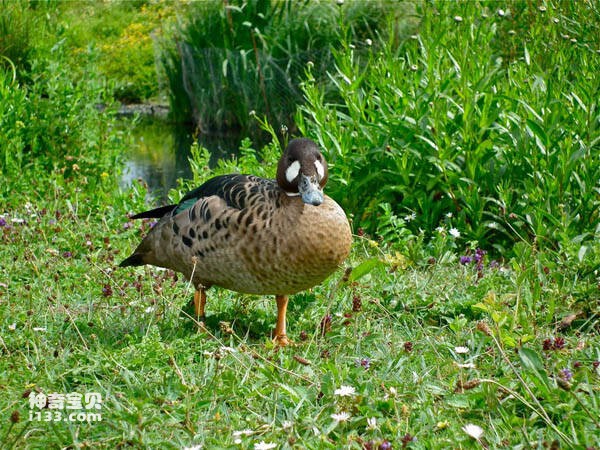Spectacled Duck
IUCN
LCBasic Information
Scientific classification
- name:Spectacled Duck
- Scientific Name:Spectacled Duck,Bronze-winged Duck,Speculanas specularis
- Outline:Waterfowl
- Family:
Vital signs
- length:46-54cm
- Weight:No textual research information is available
- lifetime:No textual research information is available
Feature
It's a spectacled duck with a distinctive head and neck
Distribution and Habitat
It is found in South America, including Colombia, Venezuela, Guyana, Suriname, Ecuador, Peru, Bolivia, Paraguay, Brazil, Chile, Argentina, Uruguay, and the Malvinas Islands (also known as the Falkland Islands).
It is commonly found in rivers, fast-flowing streams, densely wooded areas and lakes.
Appearance
The copper-winged duck, 46-54 cm long, is a medium sized water duck, a spectacled duck with a distinctive head and neck. Dark brown overall, there is a striking pure white spot in front of the eyes, and an enlarged white neck spot from the neck and throat. The upper body is generally dark chocolate brown, while the lower body is pale gray to light brown. The black wings have a metallic copper sheen, with Burgundy mirrors and colorful plumage. The sexes are similar in appearance, but the female duck has a slightly lighter plumage, while the young duck generally has less distinctive white markings on the cheeks.
Details
Anas specularis: Spectacled Duck, Bronze-winged Duck, belonging to the family Anatidae.

The copper-winged duck mainly floats on the surface of the water and gets its food underwater, subsisting on plant food and sometimes animal food. Ducks have webbed toes, but rarely dive, swim with their tails out of the water, and are good at feeding, splashing and mating in the water. Like clean, often in the water and on the land preening carefully dressed. Usually in pairs or small groups. It feeds on plant seeds, leaves and stems of aquatic plants, and also eats some aquatic invertebrates.

The breeding season of copper-winged ducks is from September to October, and the spawning season peaks in October to November. A bowl-shaped nest is built from the stems of plants and grasses. The nest rises above the nearby water and is hidden among the water grasses. Each nest lays 4 to 8 eggs and incubates for about 30 days. The ducklings are usually hatched alone by the female ducks, and are still cared for by the female ducks after hatching.
Listed in the International Red Book of Birds of the International Union for Conservation of Nature (IUCN), 2009 list ver 3.1 - Near Threatened (NT).
Protect wild animals and eliminate wild meat.
Maintaining ecological balance is everyone's responsibility!
Anas specularis: Spectacled Duck, Bronze-winged Duck, belonging to the family Anatidae.

The copper-winged duck mainly floats on the surface of the water and gets its food underwater, subsisting on plant food and sometimes animal food. Ducks have webbed toes, but rarely dive, swim with their tails out of the water, and are good at feeding, splashing and mating in the water. Like clean, often in the water and on the land preening carefully dressed. Usually in pairs or small groups. It feeds on plant seeds, leaves and stems of aquatic plants, and also eats some aquatic invertebrates.

The breeding season of copper-winged ducks is from September to October, and the spawning season peaks in October to November. A bowl-shaped nest is built from the stems of plants and grasses. The nest rises above the nearby water and is hidden among the water grasses. Each nest lays 4 to 8 eggs and incubates for about 30 days. The ducklings are usually hatched alone by the female ducks, and are still cared for by the female ducks after hatching.
Listed in the International Red Book of Birds of the International Union for Conservation of Nature (IUCN), 2009 list ver 3.1 - Near Threatened (NT).
Protect wild animals and eliminate wild meat.
Maintaining ecological balance is everyone's responsibility!








